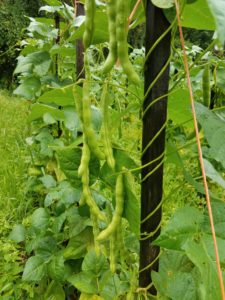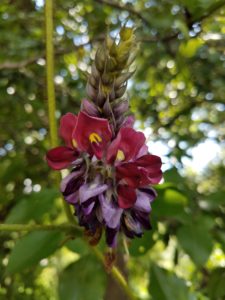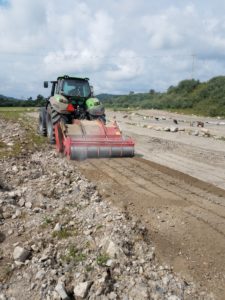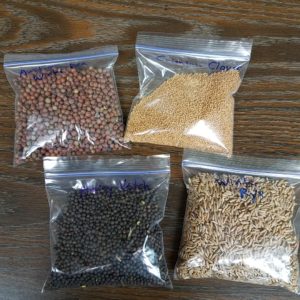Two of our Grow Appalachia family were in the office this morning to pick up fall cover crop seeds, and both made comments along the lines of “I was going to pull up my bean vines for the year, but they won’t stop producing!” It’s been a good bean year here in Wise County. Here are a few pictures of beans and other things from the last month…
 Some White Hasting beans that one of our families grow every year. I learned from them that there are regular White Hastings, Pink-Tip White Hasting and Purple-Tip White Hasting, and they grow all three.
Some White Hasting beans that one of our families grow every year. I learned from them that there are regular White Hastings, Pink-Tip White Hasting and Purple-Tip White Hasting, and they grow all three.
 A healthy patch of buckwheat, soon to be planted with greens
A healthy patch of buckwheat, soon to be planted with greens
 During our August Garden Walk, Gardener Robert let his three geese and one duck out to socialize with the group. Then it took some persuading to get them back in.
During our August Garden Walk, Gardener Robert let his three geese and one duck out to socialize with the group. Then it took some persuading to get them back in.
 An impressive compost pile that one of the growers maintains
An impressive compost pile that one of the growers maintains
 A group of 4-H students traveled to a Grow Appalachia grower’s garden as part of one of the Summer Day Camps.
A group of 4-H students traveled to a Grow Appalachia grower’s garden as part of one of the Summer Day Camps.
 Kudzu bloom. Our Master Naturalists have stressed — in regards to insects — that not everything that’s ugly is your enemy. On the other hand, not everything that’s pretty is your friend.
Kudzu bloom. Our Master Naturalists have stressed — in regards to insects — that not everything that’s ugly is your enemy. On the other hand, not everything that’s pretty is your friend.
 This wasn’t a Grow Appalachia trip, but I took a small group over to a demonstration site in Mingo County, WV. Nathan Hall and Reclaim Appalachia are using a stone crusher on reclaimed lands and planting horticultural crops.
This wasn’t a Grow Appalachia trip, but I took a small group over to a demonstration site in Mingo County, WV. Nathan Hall and Reclaim Appalachia are using a stone crusher on reclaimed lands and planting horticultural crops.
 FCS Agent Emily Wells taught the second of two workshops in August for our Grow Appalachia family. This one was on food preservation. If I learned anything, it’s that botulism is a bad way to go.
FCS Agent Emily Wells taught the second of two workshops in August for our Grow Appalachia family. This one was on food preservation. If I learned anything, it’s that botulism is a bad way to go.
 Beans, beans, beans
Beans, beans, beans
 Six of our Grow Appalachia growers entered items into our Extension Fair in late August, and all of them took home some ribbons.
Six of our Grow Appalachia growers entered items into our Extension Fair in late August, and all of them took home some ribbons.
 Cover crops: Austrian winter pea, crimson clover, winter rye, hairy vetch.
Cover crops: Austrian winter pea, crimson clover, winter rye, hairy vetch.


Leave A Comment